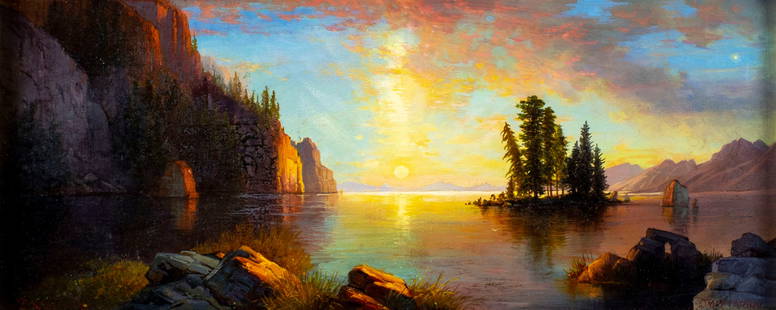
Louisa Lizbeth Chase, American (1951-2016), Untitled,
Similar Sale History
View More Items in PaintingsRelated Paintings
More Items in American Paintings
View MoreRecommended Art
View More









Item Details
Description
Louisa Lizbeth Chase American (1951-2016) Untitled, 1989 oil on canvas signed and dated verso. Paint flaking upper edge along stretcher. From The New York Times obituary: "Louisa Chase, Painter of Geometric Shapes and Body Parts, Dies at 65" by William Grimes, May 16,2016 Louisa Chase, whose turbulent canvases, with their landscape-derived images and ghostly torsos and hands, made her one of the brightest young stars in the much-heralded resurgence of painting in the 1980s, died on May 8 at her home in East Hampton, N.Y. She was 65. The cause was cancer, her brother, Ben, said. Ms. Chase arrived in New York in the mid-1970s, a pregnant moment when minimalism and conceptual art were loosening their grip, allowing a new generation of painters to come to the fore, many of them grouped in the mini-movement known as New Image Painting. Her work was distinctive: cartoonishly rendered hands and torsos, floating on expanses of candy colors. In one series, she cast Christian saints, represented as headless figures, adrift on a sea of scattered geometric forms. Critics and curators took note, recognizing affinities with the New Image style of visually arresting emblems superimposed on abstract, brushy grounds. Ms. Chase was given a solo show at Artists Space in 1975, and in 1979 her painting “Tears, Ocean II” was included in the manifesto-like exhibition “American Painting: The Eighties” at New York University, organized by the critic Barbara Rose. Her approach to landscape soon took on apocalyptic overtones. In her 1982 painting “Crevice,” slabs of upthrust rock tumbled against one another, with a pair of disembodied feet and ankles adding a ghostly human presence. The ragged archway of “Pink Cave,” weirdly repeated in smaller, mutated versions across the canvas, expressed sex as both promise and threat. “The forces closest to landscape are the closest to the internal forces that I am trying to understand,” Ms. Chase wrote in the catalog for “The American Landscape: Recent Developments,” a 1981 show at the Whitney Museum’s branch in Stamford, Conn. “The location is inside.” In the mid-1980s Ms. Chase began producing charged, gestural abstract work in which the landscape elements and body parts of earlier paintings became enmeshed in thickets of color and skeins of calligraphic lines. In a catalog interview for her 1991 show at Brooke Alexander, she called this “a ball of yarn sense of narration that went in and out of space.” The work, which showed affinities with the forceful, swaggering style of Neo-Expressionism, won her new admirers. In 1984 the Institute of Contemporary Art in Boston organized a traveling exhibition, “New Currents: Louisa Chase.” The same year, two of her paintings, “Woods” and “Fire,” were included in the Venice Biennale. Louisa Lizbeth Chase was born on March 18, 1951, in Panama City, Panama, where her father, Benjamin, a West Point graduate and Army major, was stationed. Her mother, the former Wilda Stengel, was a homemaker. Louisa grew up in Mount Gretna, Pa., and attended George School, a Quaker institution in Bucks County, before enrolling in Syracuse University with the intention of studying classics. Instead, she found her way to art and earned a degree in printmaking in 1973. After attending Yale’s summer program in Norfolk, Conn., in her senior year at Syracuse, she was accepted into the university’s graduate painting program, where she received a master’s degree in fine art in 1975. On graduating, she moved to New York, where she began exhibiting frequently. She also taught at the Rhode Island School of Design from 1975 to 1979 and at the School of Visual Arts in Manhattan from 1980 to 1982. She continued to push her work in an abstract direction into the 1990s, giving free rein to her tangled marks and lines. “The angry-child scratches have exploded into an allover web of messy Twombleyesque crosshatching; the individual lines gouge the built-up surfaces cruelly,” Holland Cotter wrote in Art in America, reviewing her show at the Robert Miller Gallery in 1986. The appeal of the work, he wrote, lay in its “scaled-down gestural poetry combined with Abstract Expressionist fervor.” Ms. Chase later introduced geometric shapes in primary colors, some of them suggesting the human form, like the figure with outstretched arms, made up of yellow rectangles, in “Sleepwalker” (1991). “I’m working with the most simple elements that I can,” she told the reference work World Artists. “The drawing’s just completely what it is: black, white, gray, and then the red, yellow and blue. “It’s a really different head,” she added. “I don’t think I could come up with an image now to save my life.” In her later years, Ms. Chase exhibited at the Halsey McKay Gallery in East Hampton. In addition to her brother, a conceptual artist, she is survived by her mother and by a sister, Abigail Chase. 40"H x 34"W (image) 42"H x 36"W (frame)
Buyer's Premium
- 25%
Louisa Lizbeth Chase, American (1951-2016), Untitled,
Estimate $2,500 - $3,500
6 bidders are watching this item.
Shipping & Pickup Options
Item located in Indianapolis, IN, usOffers In-House Shipping
Local Pickup Available
Payment

TOP

























![William Merritt Chase (American, 1849-1916): William Merritt Chase (American, 1849-1916) "Portrait of Louis Windmuller (1835-1913)", 1902 [sic?] oil on canvas signed far left center. Framed. 51-1/2" x 38", framed 67-1/2" x 55" Provenance: In the](https://p1.liveauctioneers.com/1007/150901/76189701_1_x.jpg?height=310&quality=70&version=1569424638)


























































